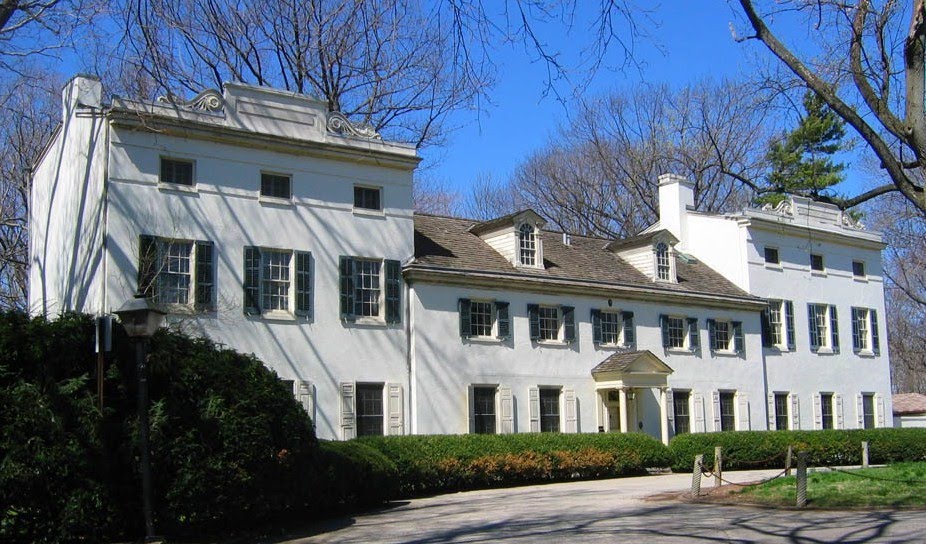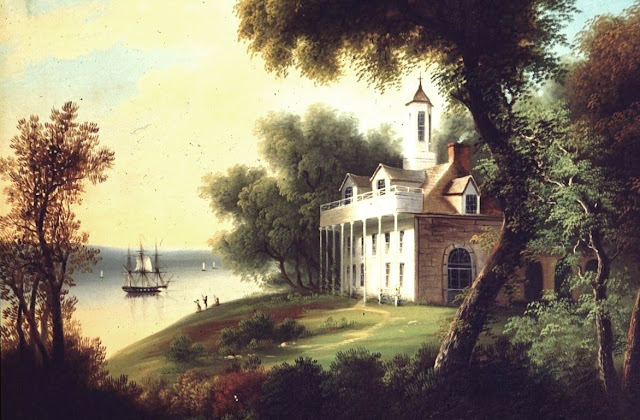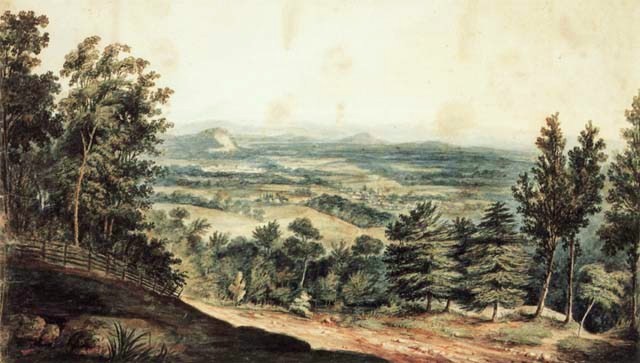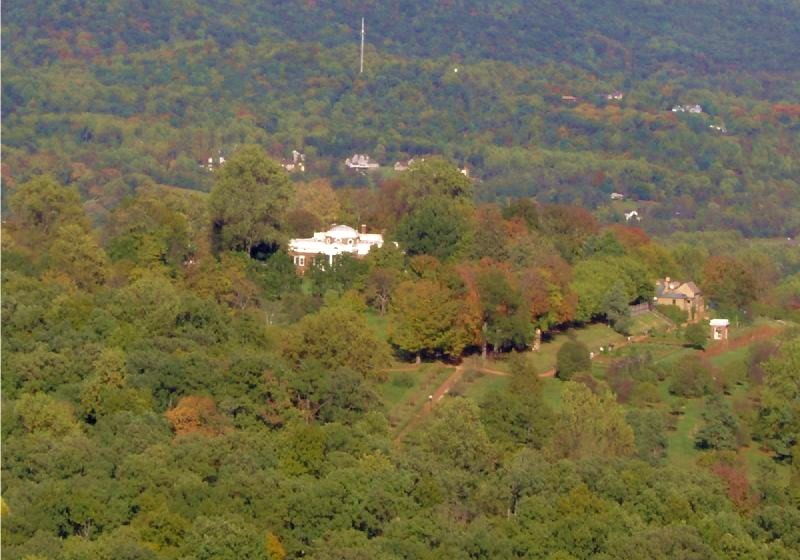During the 18th century in colonial British America and the new republic, the views from a gentleman's property were nearly as important as the view of his property from a distance. In the earlier posting
Location, Location, Location... the owner & his visitors based part of their opinion of the landholder on the view from his grounds.
A vista is an intentional view or prospect, especially one seen through an avenue of trees or opening in a woods or at the termination of a garden walk, for surveying specific pleasant aspects of the surrounding landscape.
In 18th century gardens & pleasure grounds, often ornaments, benches, or small buildings were placed a the end of a vista.
Other vistas were planned to open up to grander natural topographical features such as waterfalls or rivers.
In 1749 Charleston, South Carolina, a house-for-sale advertisement in the South Carolina
Gazette noted that,
From the house Ashley and Cooper rivers are seen, and all around are visto's and pleasant prospects.
 Recent photo of Belmont Mansion in Fairmount Park in Philadelphia. Belmont is now the home of the Underground Railroad Museum.
Recent photo of Belmont Mansion in Fairmount Park in Philadelphia. Belmont is now the home of the Underground Railroad Museum.
In the diary she kept during her rather unhappy marriage, Pennsylvania Quaker Hannah Callender (1737-1801) explained the vistas at William Peters' (1702-1786),
Belmont near Philadelphia,
Pennsylvania, in 1762,
From the windows a vista is terminated by an obelisk... We left the garden for a wood cut into vistas...One avenue gives a fine prospect of the city...Another avenue looks to the obelisk.
Peters was devoted to the design of both his dwelling and his grounds.
Belmont is one of the finest examples of Palladian architecture in the United States. Peters, an English property lawyer for the Penn family, bought the property in 1742. The attorney designed & built the mansion in 1745, planting extensive formal gardens around it.
 View of Philadelphia across the river from Belmont Park grounds today, still "a fine prospect of the city."
View of Philadelphia across the river from Belmont Park grounds today, still "a fine prospect of the city."
As the American Revolution approached, the estate passed to William's son, Richard Peters, Jr. (1744-1828), who served as Speaker of the Pennsylvania Assembly, State Senator, & U.S. District Court Judge. An amateur scientist, he began
"improving" the estate farm as a working scientific model, as were many "gentlemen" farmers of the period.
Peters was a strong supporter of the American side during the Revolution. He was a good friend & benefactor of Friedrich Wilhelm von Steuben, Inspector-General & trainer of the Revolutionary army, often paying his expenses & allowing him & his staff to stay at the family estate,
Belmont. It was there in early 1779, the
Blue Book was written becoming the first military manual of the U.S. Army. Many prominent patriots stayed at the
Belmont & walked its beautiful grounds discussing politics & war while enjoying its distant view of downtown Philadelphia, including George Washington, John Adams, Thomas Jefferson, & James Madison.
Another Fairmount Park country seat in Philadelphia shared the amazing
vista through the trees and across the Skuylkill River with
Belmont.
Mount Pleasant was built by Captain John Macpherson in 1761-62. Macpherson, a privateer who had had
"an arm twice shot off" according to John Adams, lived well as did many pirates, noted for their taste in fine houses & gardens, excellent wines, superb furnishings, & fine clothes.
 Mount Pleasant, the pirate's home in Fairmount Park, Philadelphia. The mansion now houses the Philadelphia Museum of Art in Fairmount Park.
Mount Pleasant, the pirate's home in Fairmount Park, Philadelphia. The mansion now houses the Philadelphia Museum of Art in Fairmount Park.
In 1779, Revolutionary General Benedict Arnold (1741-1801) became the next owner. The smitten, 38 year-old, widowed general presented
Mount Pleasant to his Philadelphia socialite 18 year-old bride, Peggy Shippen, as a wedding present. However, Arnold was charged with treason during the discharge of his Revolutionary War duties; and the newlyweds never lived at
Mount Pleasant to enjoy the
vista, choosing to flee to England instead.
Sharing the same Philadelphia
vista closer to the river is
Strawberry Mansion. The largest of the houses in Fairmount Park,
Strawberry was originally called
Somerton, the first house was erected about 1750. Somerton was owned by Charles Thomson (1729-1824), secretary of the Continental Congress, known as the
"Sam Adams of Philadelphia." When the British controlled Philadelphia in 1777, William Howe allowed his British soldiers to sack & burn
Somerton.
 Somerton, then Summerville, and now Strawberry Mansion in Fairmount Park, Philadelphia.
Somerton, then Summerville, and now Strawberry Mansion in Fairmount Park, Philadelphia.
In 1798, William Lewis (1752-1819), U.S. District Court Judge, built the center section calling it
Summerville. The wings were added in the mid-1820s. The present name evolves from 1842, when a Mrs. Grimes lived there & sold strawberries & cream to visitors who had crossed the river to enjoy the country air & the
vista of downtown of Philadelphia.
A loyal patriot who unfortunately died young, Josiah Quincy, was invited to share a meal in 1773, in busy Philadelphia,
Pennsylvania,
Dined with the celebrated Pennsylvania Farmer, John Dickenson Esqr, at his country seat...his gardens, green-house, bathing-house, grotto, study, fish pond...vista, through which is distant prospect of Delaware River. Both John Dickenson & Josiah Quincy Jr. (1744-1775), a Boston lawyer, were patriot newspaper propagandists and seemed to enjoy speculating on the long view.
Also on the west side of the Schuylkill River enjoying a
vista of Philadelphia is America's oldest surviving botanic garden. John Bartram (1699-1777), early American botanist, explorer, & plant collector, began his garden in 1728, when he purchased a 102-acre farm closer to Germantown.
Bartram's Garden grew into an extensive collection of familiar & intriguing native plants; as he devoted his life to the discovery of examples of new North American species. Bartram's lucrative business centered on the transatlantic transfer of plants.
Bartram died in the midst of the American Revolution; & his sons John Bartram, Jr. (1743–1812) & William Bartram (1739–1823), continued the family's international trade in plants from the beautiful garden with the
vista across the river. William became a naturalist, artist, & author. Under his influence the garden became an educational center training a new generation of scientific explorers. William’s
Travels, published in 1791, chronicled his explorations in America's Southern states.
 Charles Willson Peale's 1808 William Bartram. Independence National Historical Park.
Charles Willson Peale's 1808 William Bartram. Independence National Historical Park.
Between 1812 & 1850, Ann Bartram Carr (1779-1858), a daughter of John Bartram, Jr., maintained the family garden & business on the Schuylkill River with her husband Philadelphia printer Colonel Robert Carr (1778-1866) & his son John Bartram Carr (1804-1839). Their commercial focus remained on international trade in native North American plants.
Today 45 acres of
Bartram's Garden with its
vista across the Schuylkill River is a Philadelphia city park. The garden’s plant collection includes only a few examples of plants flourishing there during the Bartram family occupancy; however, written documentation for what was once growing in Bartram's beds is available & rich.
 Bartram's Garden, Kingsessing now Philadelphia, Pennsylvania.
Bartram's Garden, Kingsessing now Philadelphia, Pennsylvania.
In the interim between the Revolutionary War and his election to the presidency, even George Washington (1732-1799) was busy styling his
Virginia property into an artform & wrote in his diary on March 15, 1785 at
Mount Vernon,
Began to open Vistas throu the Pine grove on the Banks of H. Hole.
 Mount Vernon in 1850 by Jennie Bellows Millard. Corcoran Museum, Washington, D. C. A vista of the house & the Potomac River seen through the trees.
Mount Vernon in 1850 by Jennie Bellows Millard. Corcoran Museum, Washington, D. C. A vista of the house & the Potomac River seen through the trees.
In 1793, Rev. John Spooner described David Meade's
Maycox in Prince George's County,
Virginia,
Beautiful vistas, which open as many pleasing views of the river. One of the views from Maycox would have been of the magnificent estate
Westover, just across the river.
 Detail of the view from the rear of Governor John Eager Howard's Belvedere down to the Baltimore harbor in 1796, by George Beck. Maryland Historical Society.
Detail of the view from the rear of Governor John Eager Howard's Belvedere down to the Baltimore harbor in 1796, by George Beck. Maryland Historical Society.
French visitor Moreau de St. Mery wrote in the 1790s, of Col. John Eager Howard's
Belvedere in Baltimore,
Maryland,
The rear portion is beautified by a park. Its elevated situation; its groves of trees; the view from it...rejoice in the vistas and the sensations they inspire.
 Garden Facade of Monticello in c. 1825 by Jane Pitford Braddick Peticolas.
Garden Facade of Monticello in c. 1825 by Jane Pitford Braddick Peticolas.
In the midst of his term as President of the United States, which lasted from the spring of 1801 to the spring of 1809, Thomas Jefferson (1743-1826) was dreaming of new designs for the grounds around his personal home in Virginia.
Jefferson was constantly plotting & observing the the views &
potential vistas from points on his property at
Monticello. While Jefferson was planning on increasing the water supply at
Monticello, a practical concern, he was also interested in using that opportunity to increase the beauty of his grounds.
 View From Monticello in 1827 by Jane Pitford Braddick Peticolas.
View From Monticello in 1827 by Jane Pitford Braddick Peticolas.
He noted in 1804, at
Monticello,
Virginia,
The spring of Montalto either to be brought to Monticello by pipes or to fall over the steps of stairs in cascade, made visible at Monticello through a vista...The ground between the upper & lower roundabouts to be laid out in lawns & clumps of trees, the lawns opening so as to give advantageous catches of prospect to the upper roundabout. Vistas from the lower roundabout to good portions of prospect walks... winding up the mountain.
 Birdseye view of Monticello for a more complete view of Jefferson's gardens & grounds than available from ground level.
Birdseye view of Monticello for a more complete view of Jefferson's gardens & grounds than available from ground level.
 Birdseye view of Monticello from the higher property, Montalto (big hill), which Thomas Jefferson owned.
Birdseye view of Monticello from the higher property, Montalto (big hill), which Thomas Jefferson owned.
 Recent photo of Belmont Mansion in Fairmount Park in Philadelphia. Belmont is now the home of the Underground Railroad Museum.
Recent photo of Belmont Mansion in Fairmount Park in Philadelphia. Belmont is now the home of the Underground Railroad Museum. View of Philadelphia across the river from Belmont Park grounds today, still "a fine prospect of the city."
View of Philadelphia across the river from Belmont Park grounds today, still "a fine prospect of the city." Mount Pleasant, the pirate's home in Fairmount Park, Philadelphia. The mansion now houses the Philadelphia Museum of Art in Fairmount Park.
Mount Pleasant, the pirate's home in Fairmount Park, Philadelphia. The mansion now houses the Philadelphia Museum of Art in Fairmount Park. Somerton, then Summerville, and now Strawberry Mansion in Fairmount Park, Philadelphia.
Somerton, then Summerville, and now Strawberry Mansion in Fairmount Park, Philadelphia. Charles Willson Peale's 1808 William Bartram. Independence National Historical Park.
Charles Willson Peale's 1808 William Bartram. Independence National Historical Park. Bartram's Garden, Kingsessing now Philadelphia, Pennsylvania.
Bartram's Garden, Kingsessing now Philadelphia, Pennsylvania. Mount Vernon in 1850 by Jennie Bellows Millard. Corcoran Museum, Washington, D. C. A vista of the house & the Potomac River seen through the trees.
Mount Vernon in 1850 by Jennie Bellows Millard. Corcoran Museum, Washington, D. C. A vista of the house & the Potomac River seen through the trees. Detail of the view from the rear of Governor John Eager Howard's Belvedere down to the Baltimore harbor in 1796, by George Beck. Maryland Historical Society.
Detail of the view from the rear of Governor John Eager Howard's Belvedere down to the Baltimore harbor in 1796, by George Beck. Maryland Historical Society. Garden Facade of Monticello in c. 1825 by Jane Pitford Braddick Peticolas.
Garden Facade of Monticello in c. 1825 by Jane Pitford Braddick Peticolas. View From Monticello in 1827 by Jane Pitford Braddick Peticolas.
View From Monticello in 1827 by Jane Pitford Braddick Peticolas. Birdseye view of Monticello for a more complete view of Jefferson's gardens & grounds than available from ground level.
Birdseye view of Monticello for a more complete view of Jefferson's gardens & grounds than available from ground level. Birdseye view of Monticello from the higher property, Montalto (big hill), which Thomas Jefferson owned.
Birdseye view of Monticello from the higher property, Montalto (big hill), which Thomas Jefferson owned.
 William Bartram, 1739-1823 by Charles Willson Peale (1741-1827) 1808
William Bartram, 1739-1823 by Charles Willson Peale (1741-1827) 1808